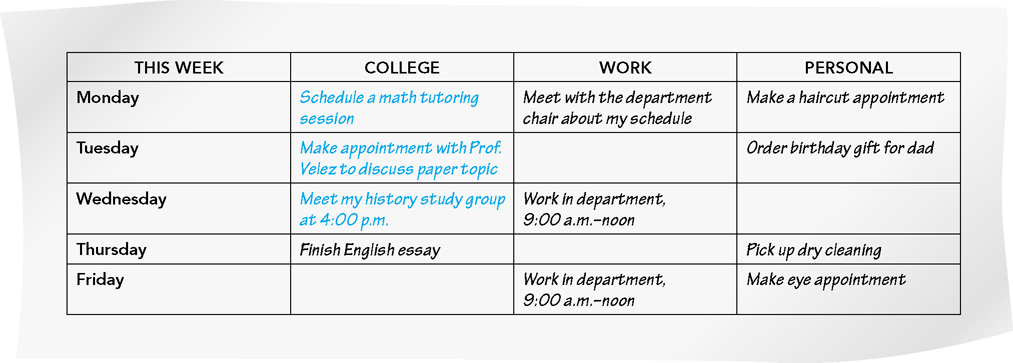SETTING PRIORITIES
As you work to overcome procrastination and limit distractions, think about how to prioritize, which means putting your tasks, goals, and values in order of importance. (Below, we’ll discuss strategies to avoid becoming overextended, which goes hand in hand with setting priorities.) Ask yourself which goals are most important, but also which ones are most urgent. For example, studying in order to get a good grade on tomorrow’s test might have to take priority over attending a job fair today, or completing an assignment that is due tomorrow might have to take priority over driving your friend somewhere.
Time Flies
Do you find yourself wondering where your time has gone at the end of a long day? Are you aware of how you spend your time when you’re not in class, or does this time just seem to vanish? Of all the time-management strategies presented in this chapter, developing an awareness of how you spend your time might be the most important. Using a day planner or your smart phone, develop an “ideal” hour-by-hour schedule that covers the next week. At the end of each day, go back and check to see if you used your time as planned. If not, make sure your projections were realistic, adjust them if necessary, and then try some of the strategies presented in this chapter to improve your ability to control the way you spend your time.
However, don’t ignore long-term goals in order to meet short-term goals. With good time management, you can study during the week prior to the test so that you can attend the job fair, too. Skilled time managers often establish priorities by maintaining a term calendar and to-do lists on which they rank the items in order of importance to determine schedules and deadlines for each task.
From the beginning of the term, plan your work on term papers and major projects that might not be due for several weeks or even months. Consult with a tutor or a more experienced student to help you break large assignments down into smaller steps, such as choosing a topic, doing research, creating an outline, or writing a first draft. Once you have entered your future commitments in a term planner and decided how your time will be spent each week, create your to-do list, which is especially handy for last-minute reminders. A to-do list helps you keep track of errands to run, appointments to make, and anything else you might forget. You can keep this list on your cell phone or tablet, in a notebook, or on a bulletin board in your room. Use your to-do list to keep track of all the tasks you need to remember, not just academics. Consider developing a system for prioritizing the items on your list: using different colors of ink for different groups of tasks; highlighting the most important assignments; marking items with one, two, or three stars; or adding letters A, B, C, and so on to indicate which tasks are most important (Figure 2.4).

FIGURE 2.4  To-Do List
To-Do List
You can keep a to-do list on a mobile device, in a notebook, or on a bulletin board. Use it to keep track of all the tasks you need to remember, not just academics. Consider adding Saturday and Sunday as these are productive days for many busy people. As you complete a task, cross it off your list. Enjoy the satisfaction of each accomplishment.

Set Priorities Like the Pros
Professional coaches help their teams thrive by setting effective priorities, whether it’s making a plan for the next play, for the whole game, or for an entire season. In setting your own priorities, take a lesson from these coaches: Prioritize your long-term plans while making sensible play-by-play decisions every day.
Jeff Gross/Getty Images